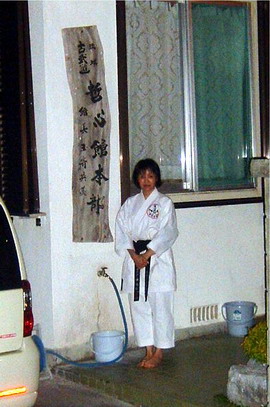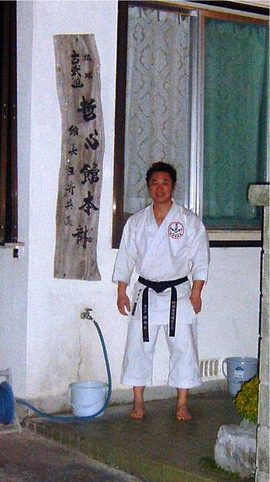


|
Ryukyu Kobudo is the term used for the ancient art of Okinawa Weaponry. The oldest documented history for Kobudo is believed to be around 1762 with Sakagawa Chikodun Peichin Kanga (1733-1815), also nicknamed “Sakagawa Tode” (China Hand Sakagawa). Sakagawa, a native of Okinawa, traveled to China to learn the art of Tode (China Hand) and with it the use of the cudgel (Bo). Another master responsible for the growth of Ryukyu Kobudo was a man by the name of Yabiku Moden. Yabiku learned much of his weapons from Chinen Sanda and in 1911 he formed the Ryukyu Kobujutsu Kenkyu Kai, the Association for the Study of Ryukyu Ancient Weapons Arts. In 1925, Yabiku set up his dojo in Gumma Prefecture in mainland Japan. Yabiku’s most famous student was Taira Shinken. Traditional Kobudo includes the use of the following weapons: Bo (Cudgel), Sai (Metal Fork), Tekko (Horse shoe), Nunchaku (Horse Bridal), Eku (Oar), Tonfa (Mill grind Handle), Kama (Sickle), Tinbe Rochin (Shield and Short Spear), and Suruchin (Weighted Chain). The Literal MeaningOkinawan Kobudo is a Japanese term which can be translated as "Old Martial Way of Okinawa". It generally refers to several different weapon traditions of Okinawan origin. Contrary to popular belief and martial arts myths, Okinawan weapons were not derived from farm implements. Peasants did not have the time or energy to devote themselves to studying farm tools for martial use. Secondly, an anxious commoner armed with clumsy farm tools would not fare well against a trained professional warrior with a variety of well made weapons at his disposal. The ScienceThe principles of traditional Kobudo are those of physical science. As with any science, there are basic laws that are integral to its application. In training, the primary intention is to mold the body to accord these physical laws. By repetition of movement, it is the goal to master the correct mechanics so that techniques are executed without conscious effort. At this level, the body has been trained into an instrument of offensive and defensive potential. The ArtWhen the aim is directed towards something beyond physical prowess, traditional Kobudo becomes an art. The practical and philosophical aim of training is to unite the mind and the body together as one. We cannot achieve perfection in our body without achieving perfection in our mind. Conditioning our movements to the correct standards of execution requires tremendous physical effort and concentration of will. Individuals will encounter obstacles in Kobudo training which they must overcome; thus, committing to a pathway until success is achieved. |
|
With the growth of the “K-1”, “sports jujitsu” and “no holds barred” matches, many of the traditional Martial Arts have taken a backseat in popularity in Japan today. The study of Okinawan weaponry or “Kobudo” is one such art that seemed to have peaked out by the mid eighties. Kobudo, which translates to the “old martial way”, is the study of traditional weapons that the Okinawans used and adapted in the Ryukyu peninsula near the end of the Tokugawa Shogunate in the early 1600’s. Some of the more mainstream weapons which most Kobudo-ka are familiar with are: • Bo, or Rokushaku Bo, or Kon — six foot cudgel which is the oldest form of weapon in the world • Sai, or Manji Sai — an iron fork which originated in China and used as a symbol of authority by government officials • Tonfa — a wooden handle thought to have been originally used to rotate a mill grinder. Similar weapon was also found in China and southeast Asia which predated the Okinawan version • Kama — bladed sickles used to cut harvest on a farm • Nunchaku — two or more pieces of wood joined by horsehair. May have originated as a horse bridle • Eku — an oar used by Okinawan fishermen • Timbei and Rochin — short spear and shield • Tekko or Techu — Okinawan brass knuckles made from metal or wood. Thought to have originated as a horse stirrup • Suruchin — metal chain with a weight on the end. Originally a rope with rocks tied to the ends. The actual origin of Kobudo is very difficult to pinpoint. According to history, perhaps the two most documented individuals traced are Sakagawa Kanga (1733-1815) and Chatan Yara (1740-1812). It is believed that Sakagawa had learned much of his martial arts from China, much like his contemporary Chatan Yara. In fact, if one looks at both kata Sakagawa no kon and Chatan Yara no kon, similarities of techniques can be seen. Sakagawa bestowed his knowledge in weaponry to several of his students like; Ginowan Donchi, Matsu Higa and Chinen Chikudun no Peichin of which much of today’s Kobudo can be traced. In Okinawa and Japan today, there are several groups that still practice the art of Kobudo that I will briefly describe. Ryukyu Kobudo Hozon Shinko-Kai Taira Shinken KobudoChinen Chikudun no Peichin had passed on all of Sakagawa’s teaching to his prize student Chinen Sanda. Chinen Sanda also picked up the weapon syllabus of Chatan Yara from a man named, Chinen Shichiyanaka. Chinen Sanda’s most famous students were; Chinen Masami, Oshiro Chojo and Yabiku Moden. Yabiku Moden initiated a preservation process for Kobudo by forming the Ryukyu Kobujitsu Kenkyu Kai in 1911. Yabiku’s most famous student was, Shinken Taira (1898-1970) who was instrumental in spreading Kobudo worldwide. Not only did Taira learn from Yabiku, but he also learned from whomever that wanted to teach him. As a result, Taira accumulated so many Kobudo kata which was unmatched by others. Taira also taught students from different styles of Karate, and by doing so he had to adapt his techniques to fit the regiments of each style. Taira also created his own kata, which has now become famous such as Kongo no Kon, Maezato no Tekko and Jigen no Sai. Taira travelled between Okinawa and Japan that resulted in a great number of students including Sakagami Ryusho, Hayashi Teruo, Mabuni Kenei, Suzuki Seiko, Fumio Demura, Meitoku Yagi, Kuniba Shogo, Izumigawa Kanki, Yara Choi, Inoue Motokatsu, Nakamoto Masahiro and Akamine Eisuke. Yamani Chinen Ryu BojutsuAs mentioned earlier, Chinen Sanda was taught Sakagawa’s weapons thorough his father Chinen Chikudun no Peichin and Chatan Yara’s weapons thorough Chinen Shichiyanaka. Chinen Sanda was also the founder of Yamani Ryu that was named by his son, Chinen Masami. Yamani Ryu is famous for its cudgel style that is characterized by highly combative yet free flowing movements. Chinen Sanda was also responsible for creating the Shuji (Shushi) no kon kata, which is famous to all Kobudo practitioners. He also devised Shirotaru no kon and Yonegawa no kon which are also legendary. Chinen Sanda’s son Chinen Masami inherited the style and was believed to be the last heir who died in 1976. The style still exists thorough the teachings of two of Masami’s students: Higa Seitoku and Kishaba Chogi. Matayoshi KobudoMatayoshi Shinko who was born in 1888 founded the Matayoshi style. He had learned much of his weapons from his uncle Higa of Gushikawa village in Okinawa. Higa was also known as “Agena” and passed on the knowledge of the bo, sai, kama, and eku to Matayoshi. Shinko also learned the tonfa and nunchaku from a man named Irei Okina. Matayoshi’s skill was so good that in 1917 he was invited to Kyoto to perform kama jutsu at the Butokuden in company with Shotokan founder Gichin Funakoshi. On March 6, 1921 he also performed for Prince Hirohito at the Shuri Castle. Matayoshi also traveled to Manchuria and China where he learned Shuriken jutsu, timbei/rochin and nunte sai. The Matayoshi system is known for its Chinese influence and has in its repertoire the garden hoe and the Chinese butterfly knives. Matayoshi died in 1947 and passed on his knowledge to his son Matayoshi Shinpo. Like his father, Shinpo was a gifted martial artist who trained with Kyan Chotoku and Go Kenki. Shinpo passed away in Okinawa on September 7, 1997, at the age of 76. Ufuchiku KobujutsuThis little known art was founded by an Okinawan named, Kanakushiku Sanda (1841-1920) or in Japanese, Kinjo Sanda. He was a police commissioner (Ufuchiku) by trade, hence the name of the style. He was a student of, Bushi Matsumura and Matsu Higa. He also acquired much of his weapons knowledge on the streets of Okinawa dealing with criminals. He was also the bodyguard to the last Okinawan king, Sho Tai. Kinjo was an honorable man and committed jiha (voluntary suicide) in 1920 as a tribute to the death of King Sho Tai. His system of Kobudo was passed onto, Kina Shosei. Shosei passed away in 1981 and is now survived by a Buddhist priest named, Isa Kaisho of Futenma, Okinawa. Kenshin Ryu KobudoShito Ryu expert, Teruo Hayashi, the founder of Hayashi-Ha, founded Kenshin Ryu. Much of his Kobudo began with Taira Shinken, but then in search of more knowledge he ventured to Okinawa where he studied under, Nakaima Kenko (3rd Soke of Ryuei Ryu), Soken Hohan (3rd Soke of Matsumura Ryu Shorin Ryu) and Nagamine Shoshin (Soke of Matsubayashi Ryu). Kenshin Ryu represents a great cross section of Kobudo from different styles with a touch of Hayashi’s own interpretation. There are, of course, many other styles of Kobudo that exist throughout the world, but the ones mentioned are the most popular in Japan and Okinawa. Presently, there are groups that are promoting Kobudo in Japan and abroad. Much of the Kobudo seen are usually affiliated to certain Karate groups. In the mainstream Japanese system, much of the Kobudo is seen in the Itosukai and Hayashi-Ha form of Shito Ryu. In Japan and Okinawa today, there are organizations that do practice strictly the art of Kobudo. In Japan, there is the Yuishinkai group headed by the late Motokatsu Inoue who studied under Shinken Taira. In Okinawa there is the Ryukyu Kobudo Hozon Shinko kai headed by Akamine Eisuke who also studied under Taira. Kanagusuku Ufuchiku Kobujutsu Hozonkai Keizu under, Soke Kaishu Isa and Matayoshi Kobujutsu Kodokan Dojo under, Gakiya Yoshiaki. There are also many dojos in North America that also teach Kobudo. Styles like Shito Ryu, Ryobukai, Shotokan, Chito Ryu and other Okinawan systems will offer Kobudo training. In Canada, there are groups like Tesshinkan, Minowa-Ha, Ryukyu Kobudo Hozon Shinko Kai, and Yuishinkan that offer strictly weapons training. If you ever get the opportunity to try it, please do as it may open the doors to another side of the martial arts that you have yet to discover. |


|